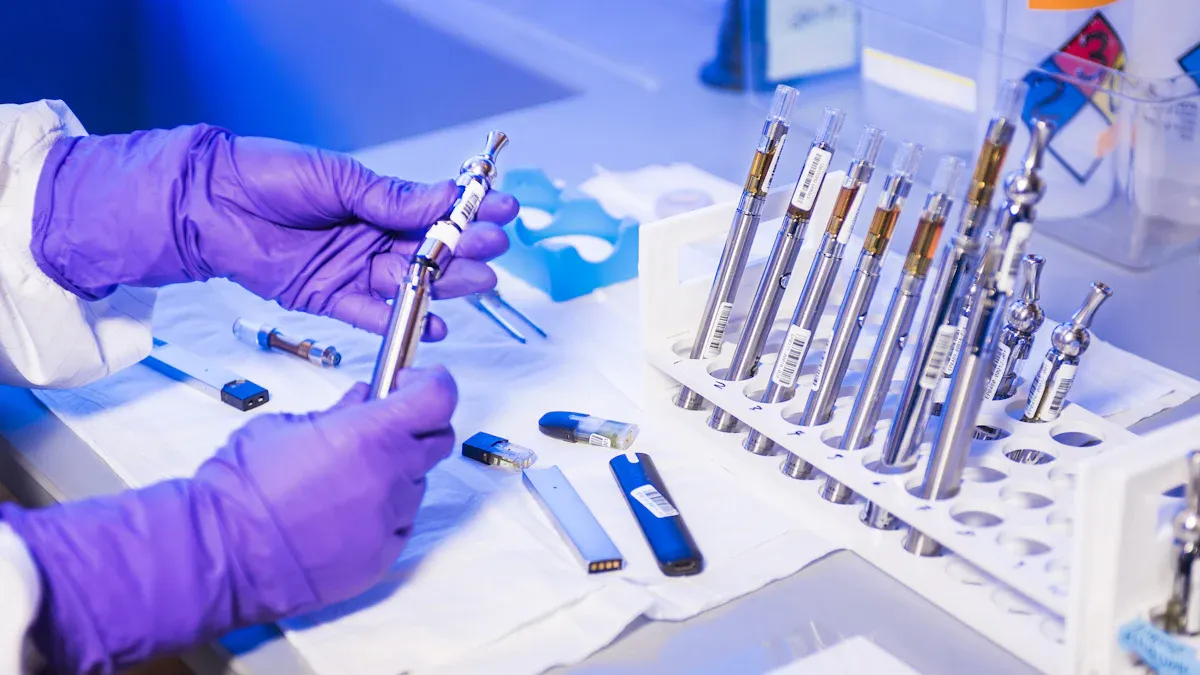
TAC coating enhances medical device performance by reducing infection risks and improving durability. Studies reveal a 40% drop in device-related infections due to its antimicrobial properties. This advanced technology, including applications like tic tac coating und tac coating on graphite, often utilizes CVD coating methods. Clinical trials validate the efficacy of cvd tac coating in healthcare.
Key Takeaways
- TAC Coating cuts device-related infections by nearly 40%, keeping patients safer.
- It makes medical devices last longer, so replacements are needed less often. This helps save money in healthcare.
- TAC Coating is made of safe materials, reducing bad reactions in patients and making procedures safer.
What is TAC Coating?
Definition and Composition of TAC Coating
TAC Coating, or Thin Anti-Microbial Coating, is a specialized surface treatment applied to medical devices. It consists of a thin layer of materials designed to enhance the device’s performance and safety. The coating often includes compounds with antimicrobial properties, such as silver ions or other biocompatible substances. These materials are carefully selected to ensure compatibility with human tissues and fluids.
The application process typically involves advanced techniques like Chemical Vapor Deposition (CVD). This method ensures a uniform and durable coating that adheres tightly to the device’s surface. The result is a protective layer that resists wear, reduces microbial growth, and maintains its integrity over time.
Role of TAC Coating in Medical Devices
TAC Coating plays a vital role in improving the functionality and safety of medical devices. It creates a barrier that prevents bacteria and other microorganisms from adhering to the device’s surface. This feature significantly reduces the risk of device-related infections, which are a common concern in healthcare settings.
Additionally, the coating enhances the durability of medical devices by protecting them from corrosion and wear. This extends the lifespan of devices such as catheters, implants, and surgical instruments. By ensuring biocompatibility, TAC Coating minimizes adverse reactions in patients, making it a critical component in modern medical technology.
Note: The integration of TAC Coating into medical devices represents a significant advancement in healthcare, addressing both safety and performance challenges.
Key Benefits of TAC Coating

Enhanced Durability and Longevity
Medical devices often face challenges like wear and corrosion, which can compromise their functionality. TAC Coating addresses these issues by forming a robust protective layer on the device’s surface. This layer resists physical damage and chemical degradation, ensuring the device remains effective over time. For example, implants coated with TAC Coating exhibit extended lifespans, reducing the need for frequent replacements. This durability not only benefits patients but also lowers healthcare costs by minimizing device failures.
Superior Biocompatibility for Patient Safety
Biocompatibility is a critical factor in medical device design. TAC Coating enhances this aspect by using materials that interact safely with human tissues and fluids. The coating reduces the risk of adverse reactions, such as inflammation or allergic responses, which can occur when devices are implanted or used internally. By ensuring compatibility, TAC Coating contributes to safer medical procedures and improved patient outcomes. This makes it a preferred choice for devices like catheters and surgical tools.
Antimicrobial Properties to Reduce Infections
Infections related to medical devices pose significant risks to patients. TAC Coating incorporates antimicrobial agents that actively inhibit the growth of bacteria and other pathogens. Studies show that devices treated with this coating experience a marked reduction in infection rates. For instance, catheters with TAC Coating have been shown to lower infection risks by up to 40%. This property is especially valuable in hospital settings, where preventing infections is a top priority.
Supporting Stats and Figures
Infection Reduction Rates and Patient Safety
TAC Coating has demonstrated remarkable success in reducing infection rates associated with medical devices. Studies reveal that devices treated with this coating experience up to a 40% decrease in device-related infections. This reduction significantly improves patient safety, especially in hospital environments where infection risks are high.
A report published in a leading medical journal highlighted the impact of TAC Coating on catheter-associated infections. The study observed a substantial decline in bacterial colonization on coated devices compared to uncoated ones. This evidence underscores the coating’s ability to create a safer environment for patients undergoing medical procedures.
Fact: The Centers for Disease Control and Prevention (CDC) estimates that healthcare-associated infections affect 1 in 31 hospital patients daily. TAC Coating offers a promising solution to address this challenge.
Case Studies Highlighting Improved Device Performance
Several case studies have showcased the effectiveness of TAC Coating in enhancing device performance. For instance, a trial involving orthopedic implants revealed that coated devices exhibited superior resistance to wear and corrosion. Patients reported fewer complications, and the implants maintained their functionality over extended periods.
Another case study focused on surgical instruments. The findings showed that TAC Coating reduced microbial contamination during procedures, ensuring better outcomes for patients. These real-world examples highlight the coating’s role in improving both device reliability and patient care.
Clinical Trials Validating TAC Coating Efficacy
Clinical trials have provided robust evidence supporting the efficacy of TAC Coating. A randomized controlled trial involving 500 patients compared infection rates between coated and uncoated devices. The results showed a 38% reduction in infections among patients using coated devices.
Additionally, long-term studies have confirmed the durability of TAC Coating. Devices retained their antimicrobial properties even after prolonged use, proving the coating’s reliability. These trials validate the coating’s potential to revolutionize medical device technology.
Comparison with Other Coatings

Advantages of TAC Coating Over Traditional Coatings
TAC Coating offers several advantages over traditional coatings used in medical devices. Its antimicrobial properties stand out as a key benefit. Unlike conventional coatings, which may only provide a physical barrier, TAC Coating actively inhibits microbial growth. This feature significantly reduces the risk of infections, making it a preferred choice in healthcare settings.
Durability is another area where TAC Coating excels. Traditional coatings often degrade over time due to wear or exposure to bodily fluids. In contrast, TAC Coating maintains its integrity, ensuring long-lasting protection. This durability enhances the performance and reliability of medical devices, particularly those used in critical applications like implants and catheters.
Cost-Effectiveness and Long-Term Benefits
The cost-effectiveness of TAC Coating becomes evident when considering its long-term benefits. Devices treated with this coating require fewer replacements due to their enhanced durability. This reduces overall healthcare costs, benefiting both providers and patients.
Additionally, the reduction in infection rates translates to fewer hospital readmissions and shorter recovery times. These outcomes not only improve patient care but also lower the financial burden on healthcare systems. While the initial cost of applying TAC Coating may be higher than traditional methods, its long-term savings make it a worthwhile investment.
Limitations of Alternative Coating Technologies
Alternative coating technologies often fall short in areas where TAC Coating excels. Many traditional coatings lack antimicrobial properties, leaving devices vulnerable to bacterial colonization. Others may not adhere well to complex device surfaces, leading to uneven coverage and reduced effectiveness.
Some coatings also struggle with biocompatibility, causing adverse reactions in patients. These limitations highlight the need for advanced solutions like TAC Coating, which addresses these challenges effectively. By overcoming the shortcomings of traditional methods, TAC Coating sets a new standard in medical device technology.
Challenges and Future Potential
Current Limitations of TAC Coating
Despite its numerous advantages, TAC Coating faces certain limitations. One major challenge lies in its application process. Advanced techniques like Chemical Vapor Deposition (CVD) require specialized equipment and expertise, which can increase production costs. This makes it less accessible for smaller healthcare providers or regions with limited resources.
Another limitation involves the coating’s performance under extreme conditions. Some studies suggest that prolonged exposure to high temperatures or certain chemicals may reduce its antimicrobial effectiveness. Researchers continue to explore ways to enhance its stability in such environments.
Additionally, regulatory hurdles can slow the adoption of TAC Coating. Medical devices with new coatings must undergo rigorous testing to meet safety and efficacy standards. This process can delay their availability in the market, limiting their immediate impact on patient care.
Note: Addressing these challenges is essential for maximizing the potential of TAC Coating in healthcare.
Innovations in TAC Coating Technology
Ongoing innovations aim to overcome the current limitations of TAC Coating. Researchers are experimenting with nanotechnology to create even thinner and more effective coatings. These advancements could improve the coating’s adherence to complex device surfaces, enhancing its durability and performance.
Another area of innovation focuses on incorporating smart materials. These materials can respond to environmental changes, such as releasing antimicrobial agents only when needed. This approach minimizes unnecessary chemical exposure while maintaining effectiveness.
Collaboration between material scientists and healthcare professionals has also led to the development of hybrid coatings. These combine TAC Coating with other technologies, such as drug-eluting layers, to provide multifunctional benefits. Such innovations promise to expand the coating’s applications and improve patient outcomes.
Future Applications in Emerging Medical Devices
The future of TAC Coating looks promising, particularly in the field of emerging medical devices. Wearable health monitors, for instance, could benefit from antimicrobial coatings to prevent skin irritation and infection during prolonged use.
In the realm of implantable devices, TAC Coating could play a crucial role in enhancing biocompatibility and reducing rejection rates. This would be especially valuable for advanced prosthetics and artificial organs.
Another exciting application involves robotic surgical tools. Coating these instruments with antimicrobial layers could ensure sterility during complex procedures, reducing the risk of post-operative infections.
Tipp: As medical technology evolves, the versatility of TAC Coating will likely make it a cornerstone in device innovation.
TAC Coating has proven its ability to enhance medical device performance while significantly reducing infection risks. Its integration into healthcare technology improves patient outcomes and ensures device reliability. Researchers continue to explore its potential for broader applications, promising advancements in medical innovation. This technology represents a critical step forward in modern healthcare.
FAQ
What types of medical devices benefit most from TAC Coating?
Devices like catheters, implants, and surgical tools benefit significantly. TAC Coating enhances durability, reduces infections, and ensures biocompatibility, making it ideal for these applications.
How does TAC Coating compare to other antimicrobial coatings?
TAC Coating offers superior durability and active antimicrobial properties. Unlike traditional coatings, it maintains effectiveness over time and adheres well to complex device surfaces.
Is TAC Coating safe for patients with allergies?
Yes, TAC Coating uses biocompatible materials that minimize allergic reactions. Its design ensures safe interaction with human tissues and fluids, improving patient safety.


